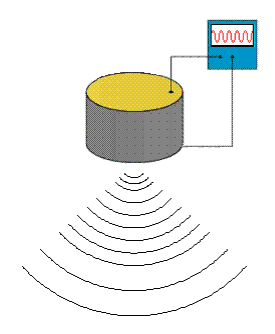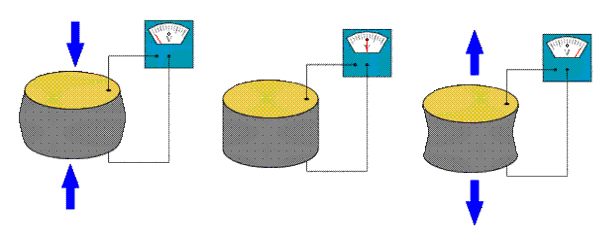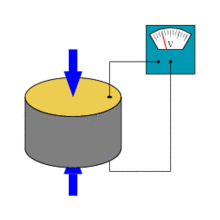Ultrasound emissions are sound waves that have a frequency greater than 20 KHz.
Ultrasound waves are generated by applying an alternate current to a piezoelectric ceramic disc made of synthetic plumbium zirconium titanate (PZT), which is located inside the hand probe. This piezoelectric ceramic disc contracts and expands at the same frequency at which current changes polarity.
Consequently the ultrasound field generated by the piezoelectric ceramic disc makes the molecules in the sound field vibrate and oscillate.
As the energy within the ultrasound wave passes through biological tissues, it will cause oscillation of the molecules. Clearly any increase in the molecular vibration in the tissue can result in heat generation, so ultrasound can be used to produce thermal changes within biological tissues.
In addition to thermal changes, the vibration of molecules generates also mechanical effects within biological tissues, which are generally considered to be non-thermal in nature. These effects include mechanical vibration, cavitation, acoustical streaming and microstreaming.
High-Frequency ultrasound (1 MHz – 3 MHz range) vs. Low-Frequency / Longwave ultrasound (38 kHz – 50 kHz range)
 Therapeutic ultrasound frequencies are traditionally between 1 MHz and 3 MHz.
Therapeutic ultrasound frequencies are traditionally between 1 MHz and 3 MHz.
EQ Pro Therapy longwave / low frequency ultrasound emissions are in the 38 kHz range.
Basic physical principles of ultrasound demonstrate that the lower the ultrasound frequency, the deeper the penetration. This is mainly due to the fact that the higher the ultrasound frequency, the higher the absorption by superficial tissues.
When comparing EQ Pro Therapy emission (38 kHz +/-2) to the one of traditional high frequency therapeutic ultrasounds (1-3MHz), penetration is one of the biggest differences, since the effects of high frequency ultrasounds are much more superficial, being readily absorbed by superficial tissues.
It is known that 1MHz and 3MHz ultrasound emissions are absorbed at different rates by tissues and have superficial penetration depths. The penetration depth of longwave / low frequency ultrasound (38 – 50 kHz range), because of its lower absorption and attenuation by superficial tissues, is expected to be in excess of 20 times greater than 1MHz and 3MHz ultrasound.
It is suggested that due to its lower frequency (38 kHz +/-2) and therefore greater wavelength (longwave), EQultrasound Pro Therapy emissions will penetrate further into the tissues and thus ‘reach’ deeper targets and have effects that traditional high frequency ultrasound is unable to achieve.
Furthermore low-frequency / longwave ultrasound (38 kHz – 50 kHz range) can produce intense acoustic non-thermal effects (mechanical vibration, stable cavitation, acoustical streaming and microstreaming) even at low intensity outputs.
Ultrasound intensity is measured in watts per square centimeter (W/cm2) and describes how strong the power output is. The greater the intensity, the greater the thermal and mechanical effects generated by the ultrasound emission.
It is important to note that ultrasound emission of high frequency 1-3 MHz devices will affect just superficial tissues, unless the intensity of the applied ultrasound is significantly increased in terms of W/cm2, but this can lead to burns and “hot spots” that might cause severe tissue damage.
In conclusion EQ Pro low-frequency / longwave treatment modality is able to reach deep targets and to safely produce intense mechanical effects, essential for an effective treatment of several equine musculoskeletal conditions.
EQ Pro Therapy produces positive results in the treatment of several equine soft tissue and musculoskeletal conditions. For example the EQultrasound Pro promotes the repair of deep tissue lesions, such as tendon injuries and ligament lesions. Experimental evidence indicates that ultrasound can increase the rate of protein synthesis by fibroblasts. The movement of ions such as calcium effects cellular activity, increasing the rate of phagocytosis and repair.
.


